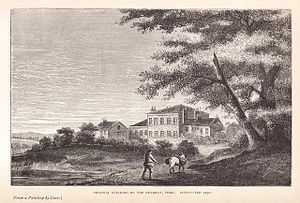Retreat (York)
York Retreat , also known as The Retreat , is the name of a psychiatric hospital founded in 1796. It was founded in York (England) by the native Quaker William Tuke (1732-1822) and the local Quaker community, the Society of Friends. The private hospital has achieved fame because the previously common forced treatment using chains and bars was only practiced in a milder form.
The English name “retreat” means not only retreat, but also a place of refuge and thus also represents a programmatic alternative to the concept of marginalized , widespread institutions for the mentally ill , but there were no more sensational scandals there, such as those that were the order of the day at Bedlam Hospital in London . The reason for the establishment of this hospital was that a few years earlier one of the members of the York Quaker Congregation, Hannah Mills , under dubious circumstances in the insane asylum of the city of York, which was founded only a few years earlier in 1777York Lunatic Asylum , had died. It was a female patient who had previously been deprived of visiting rights. The basis of the care the so-called moral treatment , the Moral Treatment .
The York Retreat is widely viewed as the forerunner of today's social psychiatry . According to Klaus Dörner, it is representative of the “self-governing spontaneity of the English bourgeoisie as well as the socio-political activity of the religious communities in England” , which the psychiatry of the continent has never achieved.
Role model
The new style of moral treatment was not the only model . The location of the hospital to the east of the city and outside the city walls in a charming environment was also seen as a defining factor in the establishment of a hospital later. This was the model for the later founding of hospitals outside the city in the unspoiled nature. However, this planning did not take into account the separation of a patient from his relatives and from the local environment of the sick, which is necessary with the new concept. Of course, this was not in the spirit of community psychiatry from today's point of view. As the illustration shows, the York Retreat was a comparatively small house that was deliberately built to ensure adequate treatment in a small, relatively private setting.
History of the hospital
The breakthrough of the competing concept of the York Retreat was the fact that the York Lunatic Asylum, founded only a few years earlier in 1777 based on the concept of William Battie , was not spared the fate of public scrutiny in 1813. Godfrey Higgins , a socially minded landowner, teamed up with the Tuke family to investigate lingering rumors about the treatment of the mad there. They discovered that these rumors were all too justified. Their research revealed that there have been cases of abuse including sexual addiction. This led to the dismissal of the board of directors at the York Lunatic Asylum and to corresponding regulations regarding further inspections.
literature
- Samuel Tuke : Description of the Retreat, an institution near York, for insane persons of the Society of Friends. London 1813.
- MR Glover: The Retreat, York. An early Quaker experiment in the treatment of mental illness. Edited by JR Glover, York 1984.
Individual evidence
- ↑ Werner E. Gerabek : Tuke, William. In: Werner E. Gerabek, Bernhard D. Haage, Gundolf Keil , Wolfgang Wegner (eds.): Enzyklopädie Medizingeschichte. De Gruyter, Berlin / New York 2005, ISBN 3-11-015714-4 , p. 1425.
- ↑ Finzen, Asmus : The Pinel pendulum. The dimension of the social in the age of biological psychiatry. Edition Das Narrenschiff im Psychiatrie-Verlag, Bonn 1 1998, ISBN 3-88414-287-9 ; Page 12 f.
- ^ Dörner, Klaus : Citizens and Irre. On the social history and sociology of science in psychiatry . [1969] Fischer Taschenbuch, Bücher des Wissens, Frankfurt / M 1975, ISBN 3-436-02101-6 ; Pages 93, 96 f.
- ↑ Foucault, Michel : madness and society . (Histoire de la folie. Paris, 1961) A story of madness in the age of reason. Suhrkamp, stw 39, 1973, ISBN 978-3-518-27639-6 ; Page 395
- ↑ Luderer, HJ: History of Psychiatry . Abridged lecture from the media day of the Thuringia Regional Association of Members of the Mentally Ill eV in Jena on June 19, 1999. See paragraphs. 18th and 19th centuries: Efforts for humane treatment of the mentally ill online
- ^ Gray, Jonathan: A history of the York Lunatic asylum . With an appendix, containing evidence of the cases of abuse lately inquired into by a Committee, & c. York: printed by W Hargrove and Co, for J Wolstenholme, York [et al], 1815
